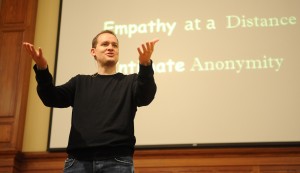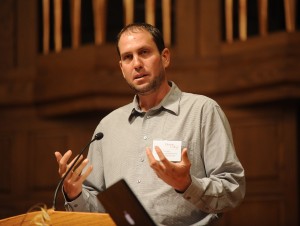
Shane Hipps has a message for the Mennonite Church: there’s a “tsunami of people coming your way because they are attracted to the Anabaptist faith.
“You have people knocking your doors down wanting to live like this,” the pastor of Trinity Mennonite Church, Phoenix, Ariz., stated at Hesston College’s Anabaptist Vision and Discipleship Series, November 7-9. While addressing the theme for the weekend, “Digital Discipleship: Forming Faith in an Electronic Age,” Hipps also offered strong affirmation and challenges for the Mennonite Church.
“It’s not just what you believe (that’s attractive),” Hipps said. “It’s how you hold your beliefs-with radical commitment and daring humility.”
Hipps likened the Anabaptist beliefs of the Mennonite Church to a clear, blue, deep pristine lake that he used to visit as a child. But that lake has since been invaded by a weed that threatens to choke it to death, he said.
“Your ‘weeds’ are born of the fact that you’ve married your faith and your culture,” he said. “Parts of your culture have nothing to do with Anabaptism and Jesus,” he said.
Those weeds are stopping the “tsunami of immigrants” at the church doors, and they include four-part singing of hymns, dress codes, quilts, knowing the acronyms of Mennonite organizations, and Mennonite last names.
Quick to acknowledge the beauty of four-part singing, Hipps explained that there is nothing wrong with the cultural aspects of the Mennonite tradition. It’s just that when it comes to welcoming non-ethnic people into the congregation, they can get in the way.
“What you have to offer is too valuable to withhold, so stop letting cultural weeds get in the way of your water,” Hipps said. “We need it too much.”
Author of the book The Hidden Power of Electronic Culture: How Media Shapes Faith, the Gospel and Church, Hipps shared his perspectives on that topic with an audience that included Hesston College students, faculty and staff, Beachy Amish from several Kansas communities, and lay persons and pastors from ten states.
“The medium is the message,” Hipps stated, and offered the example of lighting in a sanctuary. When all the lights are on and the seating is in a circle of chairs, the Gospel that is presented is one of community, openness, and vulnerability to each other. When the lights are darkened over rows of pews, the Gospel being shared nonverbally is one of isolation and individuality.
Another catch-phrase repeated by Hipps was “You become what you behold.”
“Choose what you put in front of yourself,” he cautioned, and later warned that MySpace and Facebook are addictive, especially to teenagers. Not only that, he said, but these internet options and cell phones have contributed to “a younger generation that has atrophied their social skills to a degree that is alarming.”

“The weekend was a mind-stretching time,” said Leland Nisly, bishop of the Cedar Crest Beachy Amish Mennonite Church near Hutchinson, Kan. “I was challenged to be aware of and think deeply about how the technology we use shapes us and the culture we live in, maybe as much as what we do with that technology. I appreciate Shane opening my eyes to the influence of media. Often we can’t see for ourselves how we are being shaped by the things around us, but it takes someone or something outside of ourselves to point those things out to us. I left the weekend asking the question, ‘How is this going to affect how I live and the decisions I make?’ I am still trying to answer that question.”
“I work with children and youth in the church, and I need to be aware of and accept that we are living in a digital culture,” said Joy Cotchen, Allegheny Mennonite Conference Minister of Children and Youth. “The more I can learn about and try to understand the culture we live in, the more helpful it will be in staying connected with youth. Technology is a part of everyday life, so we can fight it, try to ignore it, or learn to use it in positive ways. Shane shared a lot of helpful information about the image-based culture we live in and how it affects the way we learn. I really enjoyed his passion for the Anabaptist faith and his encouragement to be sharing Jesus with those around us.”
In addition to the plenary sessions with Hipps, the 180 participants could choose from a number of workshops related to the weekend topic. While youth pastors Derek Yoder (Hesston, Kan.) and Peter Eberly (Harrisonburg, Va.) helped participants delve into the world of Facebook, Hesston College professor and historian John Sharp was leading a session on “Playing the piano: A historical perspective on how Mennonites live with new media.” In other sessions, Michele Hershberger (Hesston College Bible professor and AVDS coordinator) and Jim Ostlund (associate pastor of Youth and Young Adults in Blooming Glen, Pa.) taught “Preaching in an electronic age,” while Gary Oyer (Hesston College director of Media Services) shared “Seven things every pastor should know about technology.”
Other workshops included “Finding depth in a busy, shallow age” (led by Gene and Mary Herr of Newton, Kansas); “Parenting in an electronic age” (led by Kevin Wilder, Hesston College faculty member); “Electronic media as a spiritual power: Conversing with Walter Wink and the New Testament” (led by Marion Bontrager, Hesston College Bible professor); “Using secular media in worship” (led by David Greiser, Hesston College Pastoral Ministries director and John C. Murray, Hesston Mennonite Church pastor); “Addiction to the media: How to use electronic media without it using you” (led by Jeffrey Roth of Prairie View); and “Community discernment and accountability: A conversation with the Beachy Amish.”
Ruth Wagner Bradshaw, pastor of Pilgrim United Church of Christ in Wichita, Kan., reflected on the weekend: “Shane Hipps helped me begin to understand the cataclysmic changes taking place in our world. It’s not just the content of various media presentations that matters; instead, the very act of using various forms of communication-print, TV, cell phones, etc.-fundamentally changes the way we think and relate to one another. This affects every aspect of our lives, including our spiritual lives. I realized we are just beginning to understand how we might use media responsibly and how we might deal with the effects of various media in an intentional way.”

